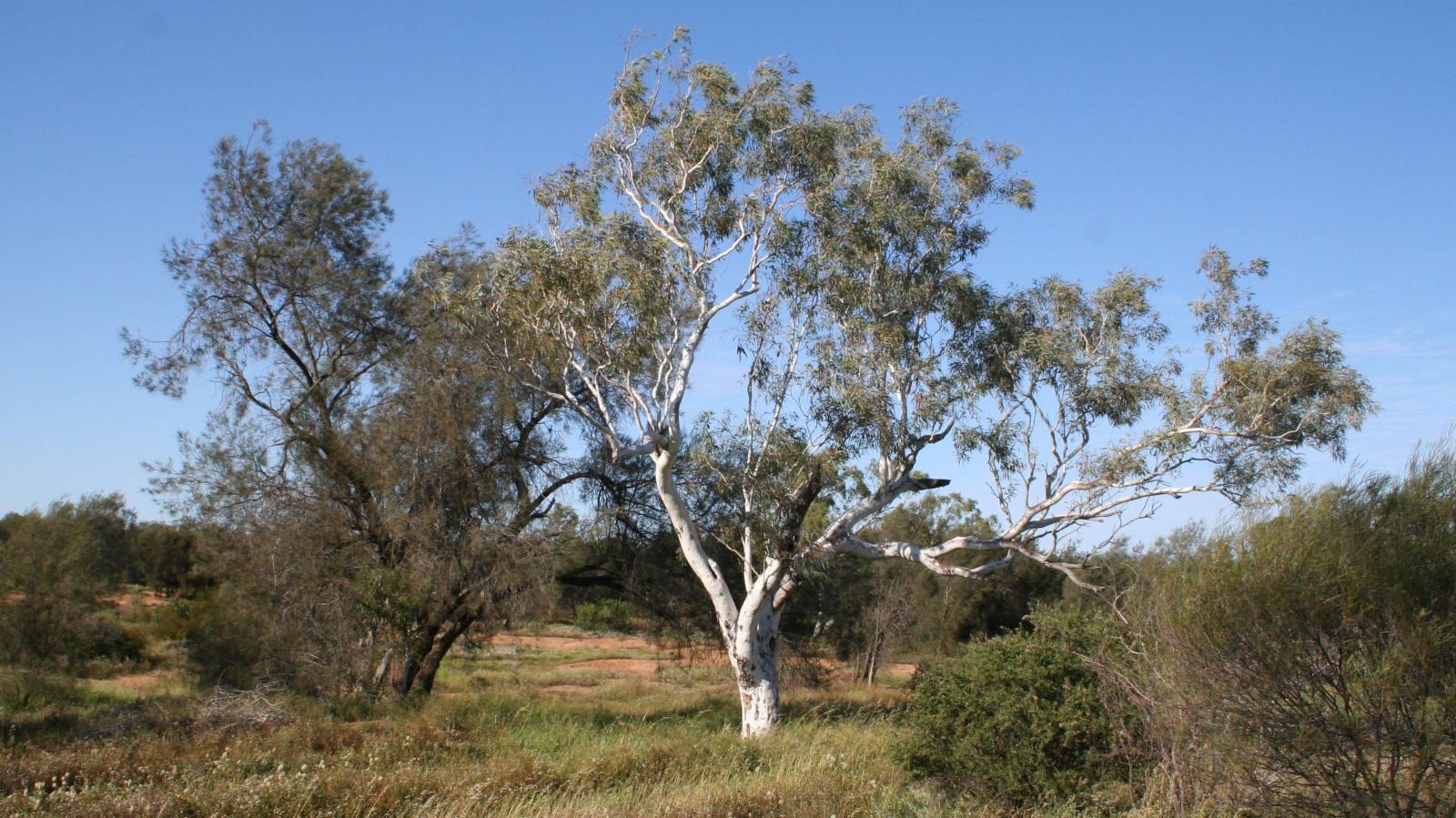River red gum is a beautiful tree found along river banks and in valleys in Australia.
Although river red gum is native, and restricted, to Australia it was first described from a cultivated plant growing in the garden of the Camaldoli religious order in Naples, Italy. This huge tree has a thick trunk and multicoloured bark, mixing grey, off-white and brown. The wood is brilliant red (hence the name red gum), but can range from pale pink to almost black in colour. There is much variation in the shape of the buds, which come into flower from December to February. This variation is seen throughout its wide distribution.
The beauty of river red gum caught the attention of Hans Heysen, a famous German painter who lived in Adelaide, Australia, painting eucalypts between the late 19th and early 20th century. Stan Kelly, a Victorian Railway driver, also dedicated a large part of his life to painting the eucalypts he 'admired the most', including river red gum.
Geography and distribution
River red gum is widespread in south-eastern Australia and southern Queensland. It is also widely cultivated, mainly in Europe and Asia, but also in California (USA), British Guiana, Venezuela, Bolivia and Africa.
Description
A medium-sized tree, generally growing up to 30 metres tall (but can sometimes become a large tree of up to 45 m), with a thick trunk covered with peeling bark. The smooth bark can be grey, pinkish grey, white or brown. The leaves are mostly alternate (one at each node), lance-shaped to narrowly so, 18-25 × 2 cm. The leaves are green or bluish green, usually the same colour on each side of the leaf, dull or glossy, with oil glands seen clearly. The inflorescence is axillary, with 7-11 white flowers with pedicels (flower stalks) of about 2.5 cm long. The buds have a scar, and the bud caps are strongly beaked or conical. The stamens (male parts of the flower) are inflexed (bent inward or downward) or erect. The fruit is hemispherical, 0.6 × 1 cm, and contains yellow to yellow-brown seeds with a terminal hilum (scar indicating the point of attachment).
Dried herbarium specimen of
Eucalyptus camaldulensis collected in Australia. Uses
The timber of Eucalyptus camaldulensis is used in construction, parquet flooring and for railway sleepers. The dried wood makes an excellent source of fuelwood and charcoal, and because of the fast growth of the tree it has been introduced for this purpose to many arid and semi-arid parts of the world. The flowers are a good source of nectar for honey production. The essential oil from the leaves has been used medicinally for treating coughs and as a vermifuge. It has been found to have antibacterial, antifungal and antioxidant activities, and has also been found to repel some species of mosquito.
E. camaldulensis has been planted with some success to reclaim sand dunes and as a windbreak in parts of the Middle East. River red gum grows on a variety of soils, and occasionally along the borders of salt lakes. As a result, some provenances can grow on saline waterlogged soils of degraded irrigation schemes. However, because of water and nutrient competition it is not recommended to plan it alongside crops.
The beauty of Eucalyptus camaldulensis , with its multicoloured bark, has inspired gardeners around the world to cultivate it, hence it is now a widely cultivated species, and reported as the most widespread of all eucalypts. Although suitable for parks and large gardens in tropical and warm temperate drylands, it is less suitable as a street tree in urban areas on account of the litter resulting from its peeling bark and dried, fallen leaves.
Damage to Landscapes in South Africa
Eucalyptus camaldulensis is one of several Eucalyptus species which is invasive in South Africa. Australia and South Africa share similar environmental conditions, and hence species that grow well in one are likely to do so in the other. River red gum, although in balance with other organisms in its native environment has caused much damage to South African landscapes where it has been introduced and become invasive. Long stretches of rivers and dam shores have been transformed by river red gum. It draws up a large amount of water from the ground, contributes to soil erosion and adversely affects nutrient cycling and soil properties.
Millennium Seed Bank: Seed storage
Kew's Millennium Seed Bank Partnership aims to save plant life world wide, focusing on plants under threat and those of most use in the future. Seeds are dried, packaged and stored at a sub-zero temperature in the seed bank vault.
Description of seeds: Average 1,000 seed weight = 2.4 g
Number of seed collections stored in the Millennium Seed Bank: Six
Seed storage behaviour: Orthodox (the seeds of this plant survive being dried without significantly reducing their viability, and are therefore amenable to long-term frozen storage such as at the MSB)
Germination testing: 98% germination was achieved with: germination medium = 1% agar; germination conditions = 20°C, 8/16. 98% germination was achieved with: germination medium = 1% agar; germination conditions = 10°C, 8/16. 91% germination was achieved with: germination medium = 1% agar; germination conditions = 15°C, 8/16.
River red gum at Kew
Pressed and dried specimens of river red gum are held in the Herbarium, one of the behind-the-scenes areas of Kew. Thedetails, including images, of some of these can be seen in the online Herbarium Catalogue.
Specimens of river red gum bark, oil, fruits, resin and wood are held in the behind-the-scenes Economic Botany Collection.



